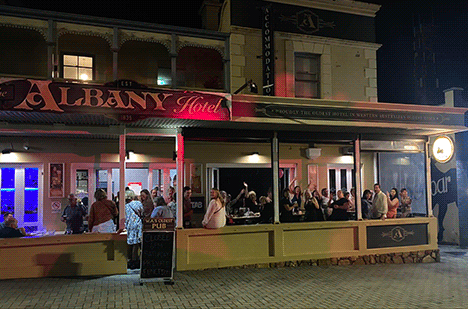Historic WA pub wipes $350K tax bill using new restructuring law

A little-known legal process has enabled Neville Walton, the publican behind Western Australia's oldest hotel, to wipe A$350,000 in debt and keep pulling beers from behind the bar.
“I’m sure [anybody would] jump at that opportunity,” Walton told The ABC.
His experience is part of a growing trend across Australia. Small businesses struggling with mounting debt are increasingly turning to a relatively new clause in the Corporations Act—called small business restructuring (SBR)—to get their finances back on track without shutting up shop.
The corporate watchdog, the Australian Securities and Investments Commission (ASIC), says there's no indication SBRs are enabling poor business behaviour, although concerns about the scheme’s long-term impact remain.
Walton took over the lease of Albany Hotel in 2017. However, a retirement dream turned sour when COVID-19 hit. The 200-year-old pub, a heritage gem in Western Australia, saw patron numbers dive and costs skyrocket.
“Something I thought I’d take on when I turned 60 was to buy a pub,” he said.
As bills piled up and the price of essentials—wages, electricity, beer—soared, GST and tax obligations were pushed to the back burner.
“Of course, [the tax debt] blew out of proportion,” Walton said. “We went on a payment plan (with the ATO) and we were going along great with that for a while, and then that got harder and harder as well.”
Eventually, he considered tapping into his superannuation or declaring business failure altogether.
“I was barely keeping my head above water,” he recalled.
It wasn’t until Walton’s bookkeeper suggested he speak to a restructuring adviser that he discovered the SBR process.
What is small business restructuring?
The SBR framework was introduced in 2021 by the Morrison government to help small operators hit hard by pandemic conditions. It allows businesses with debts under A$1 million—excluding staff entitlements—to negotiate with creditors to reduce or forgive debts while continuing to trade.
Unlike liquidation, which involves winding up operations and selling off assets, SBR keeps the business running and aims to return better outcomes for both owners and creditors.
“The idea [behind an SBR] is to give small businesses a more cost effective, faster and hopefully successful way of getting through financial difficulty and coming out the other side,” ASIC commissioner Kate O’Rourke told The ABC. “That plan sort of resets the company.”
Creditors get a vote, with influence proportional to the amount they are owed. In practice, the Australian Taxation Office (ATO) often dominates those votes.
New ASIC data shows SBRs jumped significantly in the past financial year, with around 3,000 lodged. The food and beverage sector has been particularly active, with nearly 1 in 10 businesses in that category shutting down over the past year, according to CreditorWatch.
“Any industry that is exposed to consumer spend is still doing it really tough,”
CreditorWatch chief executive Patrick Coghlan told The ABC. Construction businesses are also making heavy use of the scheme, with both sectors comprising about half of all SBR cases.
Most restructures involve debts between A$200,000 and A$400,000, and creditors are typically asked to forgive around 80% of that amount. Around four in five proposals are approved.
The ATO is involved in 93% of all SBRs and has supported about 80% of them this financial year, according to a spokesperson.
“The ATO has supported most restructuring plans where the ATO has been a creditor,” the spokesperson told The ABC. “An SBR is not a shortcut to avoid paying tax debts, it is a formal restructuring mechanism available for insolvent or likely to be insolvent businesses.”
Albany Hotel pays 22 cents on the dollar
Walton’s SBR was handled by restructuring firm Business Reset. The firm proposed paying just A$76,000 of the A$350,000 tax bill, plus a A$15,000 advisory fee—a recovery rate of just 22 cents per dollar owed.
“We could propose a restructuring proposal to the ATO showing that there were limited concerns for the future viability for the business,” said Jarvis Archer from Business Reset.
Walton is now repaying the reduced debt in instalments. If he defaults, the full amount becomes due again. But for now, he’s relieved.
“I never expected (the debt) to be wiped, to be honest,” Walton said. “Hopefully in 18 months’ time, I can come out of it debt free.”
“Cheers to the tax office, thank you.”
SBRs have their risks
ASIC data shows around 93% of businesses using an SBR remain registered one year later. But longer-term success rates are unclear.
Melbourne bakery chain All Are Welcome went through an SBR three years ago that slashed A$585,000 of debt—much of it owed to the ATO. Yet the business collapsed this year, leaving A$1.2 million owed to the tax office and A$368,000 in unpaid staff entitlements.
“Small business restructuring might be good for some businesses,” owner Boris Portnoy said in a statement, “but for the bakery that needed to grow to survive, perhaps a low interest loan might have been more helpful.”
Critics worry the SBR mechanism could facilitate phoenixing, where failing companies shed debt and re-emerge under new names. ASIC says it has not found evidence of misuse so far, and safeguards prevent directors from accessing the scheme repeatedly.
“There’s definitely positive and negatives about the SBR regime,” Coghlan said.
“They’re helping businesses… come out the other side with a cleaner balance sheet… but [they] can be utilised to avoid paying debts.”
For now, Walton is still behind the bar, hopeful that he’ll get through the next 18 months with the Albany Hotel intact.
As the small business sector continues to battle rising costs, interest rates and lingering pandemic debt, more owners like Walton may find themselves leaning on restructuring as a lifeline.
Jonathan Jackson, 14th July 2025







